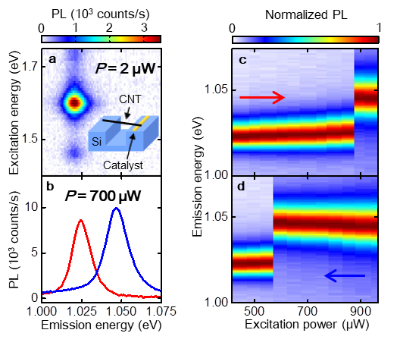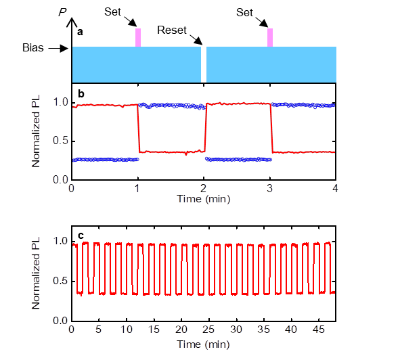Research:Single carbon nanotubes as ultrasmall all-optical memories
All-optical memories are storage devices that can be entirely operated by light including input, output, and control. It can be exploited to achieve all-optical information processing which can potentially boost the capabilities of modern information-processing systems. Since all-optical memories employ nonlinear optical effects, these devices usually require periodic dielectric structures that can enhance the light-matter interactions. The periodicity needs to be comparable to the wavelength of light, and therefore the size reduction of all-optical memories to the nanoscale limit has been difficult.
Here we report on the operation of single carbon nanotubes as optical memories, where we utilize a unique nonlinear optical effect induced by molecular screening. Our results may lead to an unconventional route for high density integration of all-optical memories.

Our samples are individual carbon nanotubes suspended over trenches on silicon substrates. The nanotubes are synthesized by alcohol chemical vapor deposition from catalyst particles placed near the trenches. For one of such suspended nanotubes, we have investigated the excitation power dependence of photoluminescence (PL) spectra. In the up-sweep power dependence, an abrupt spectral change is observed at 870 µW, which is attributed to the laser-heating induced molecular desorption. Interestingly, we find that the abrupt spectral change occurs at a much lower power for the down sweep. This result shows that the nanotube can take two different output states for the same input depending on the excitation history.

In order to confirm that these two output states can be switched by optical means, we have excited another nanotube with an excitation pattern shown in the figure above. The nanotube state can be reversibly switched from one to the other depending on the excitation laser power, demonstrating the rewritability and the stability of the single nanotube optical memory.
To learn more about this work, please refer to:
Single carbon nanotubes as ultrasmall all-optical memories
ACS Photonics
5, 559 (2018).
![]()